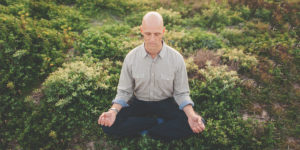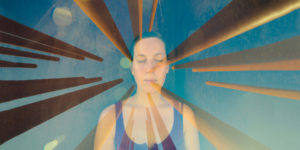Slow Yoga: 4 Poses to Bring Your Life and Practice More Deeply Into the Flow
BY MATT COOKE
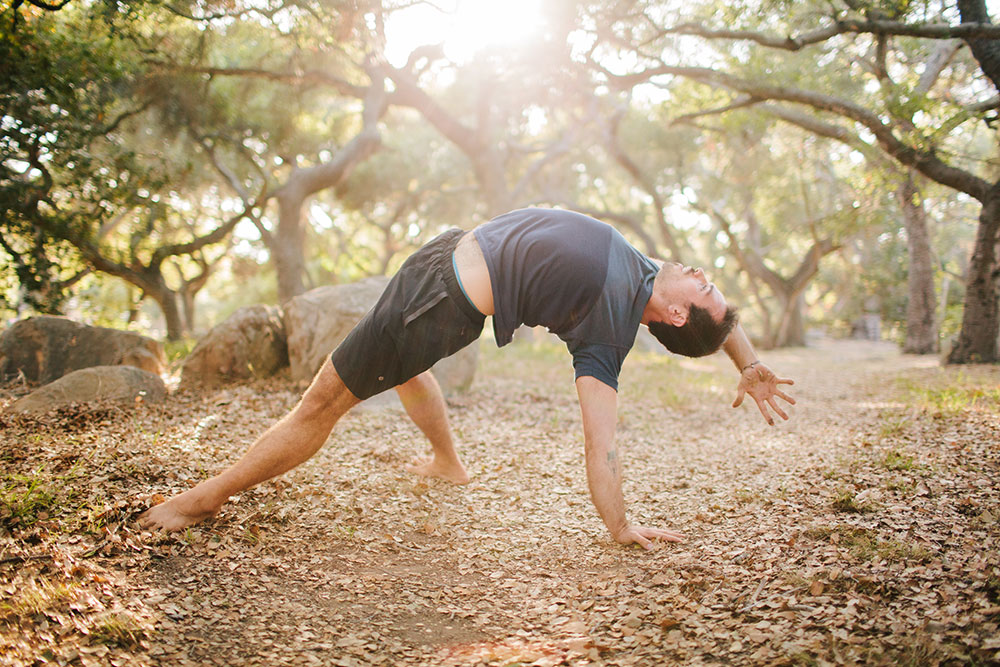 slow yoga is the art of moving more deeply into the flow through poses and mental shifts—not just in your yoga practice, but in all areas of your life.. photo: lerina winter
slow yoga is the art of moving more deeply into the flow through poses and mental shifts—not just in your yoga practice, but in all areas of your life.. photo: lerina winter
It seems counterintuitive, but what if you slowed down to speed up? To get more done by feeling clarity in the moment. To know exactly how you’re feeling, and not have ambiguity about what the next step is.
When you slow down to the speed of life—during yoga and otherwise—as it unfolds, you move with certainty. As you really experience the moment you are in, fully aware of your environment—the sounds, the smells, and sights—you most importantly slow down your thoughts.At the end of their slow yoga practice, many people notice feeling either inwardly focused and relaxed, or feeling energized and ready to conquer the world. Many of us know the power of yoga and movement to improve our posture, increase cardiac output, and improve our immune and nervous systems. During a single session, slow yoga acutely affects not only our body temperature and physiology, but also helps us slow down our brain and collect our thoughts.
We also know that slow yoga makes us feel good, but often don’t realize how it affects our neurocircuitry. Every posture, including the body language of a pose, creates a certain feeling in the practitioner. When strung together skillfully in a flowing sequence, a teacher can use a class to wake their students up or draw them deeper into themselves. Some slow yoga poses boost our confidence, power, and strength, while others draw us inward, towards contemplation and deep reflection.
Specifically, the standing slow yoga postures create a feeling of stimulation and power because many muscle groups must be engaged to safely perform the pose, while in seated and supine (on back) poses tend to lead toward introversion due to the lack of muscular engagement of these poses.
Forward folds are typically passive in slow yoga, using few muscles, with the head facing inward. In forward folds, our physical and metaphysical gaze are turned inward toward introspection. Many forward bends lend themselves to closing the eyes, and slowing down the breath and the nervous system. On a more concrete level, these yoga postures allow us to slow down and study our thought processes and mental flow. To slow down our mental chatter enough to really examine what is passing through our minds, and if they are old thoughts, to release them, or if they are new insights, to receive them. These postures lead us closer to acceptance and understanding of ourselves and the world around us.
Backbends have a very opposite effect, expanding our awareness to the details of the outside world, stimulating the nervous system, and generally speeding up the breath. These slow yoga poses work like a natural shot of caffeine to the system. Backbends also typically require much more muscular engagement in the abdomen and diaphragm to keep the spine safe, allowing us to lift and open the heart. If we feel nervous or withdrawn these are great poses to counteract that tendency, and draw our attention outward, toward extraversion.My favorite slow yoga postures are the ones that draw us nearer to ourselves. In our technologically rich society, our minds are moving so fast, often eroding our experience of life and our connection to ourselves. And conversely, our bodies are slowing down more than ever before. This weakens our attention to and awareness of our consistent thought patterns, emotions, and habits, not to mention our proprioceptive awareness of our bodies, which leads to dwindling satisfaction of our lives, and results in us missing our personal power and flow.
As we slow down our minds and stimulate our bodies with the help of our breath and slow yoga practice, we bring our being more closely into alignment—literally lining up our awareness of our body, mind and breath. We effectively level out the playing field and draw closer to our primal nature and gut instincts. We begin to listen to our intuition and desires. As a result, we are less stressed, eat less, and follow the natural rhythms and flows of our bodies rather than rely on the conditional power of stimulants and caffeine. Overall, contemplative practices, such as the Creative Warrior Movement process help us to see ourselves with more clarity, creating more decisive actions and leading us to rediscover our personal power!
Droping Into Flow: Creative Warrior Movement
Creative Warrior Movement weaves these two methodologies, with the use of a journal to expound upon your brilliant million-dollar ideas that come up while you are in deep meditative states, for example, after practicing slow yoga.
When I studied at the Kripalu Center for Yoga and Health, we were told that what we experience on the yoga mat is like a science laboratory for life off of the yoga mat. A microcosm to express and inquire about the macrocosm of our lives.
But this can also be reversed to say that you can experience more of your life off of the yoga mat, while you are on the yoga mat. You can begin to feel more clear about the challenge you’ve been having at work, or in your relationship. You can understand more about your beliefs and fears, and ultimately come to see how whole you truly are. This process on the yoga mat allows you to slow down, step back from your experiences, and get a bird’s eye view of your life. To observe all the moving pieces, and be struck with creative insight (our intrinsic body wisdom) about what the right next step is for you. To stop trying to “figure it out”, or fester endlessly on the solutions. Instead, you simply allow your body, breath, and mind to do the work.
The answers were always there inside of you. The question is, can you slow down long enough to feel them?
Right now: Slow down, breathe, and ask yourself, “What is my intrinsic wisdom telling me the answers to my challenges are?” Keep a pen and a journal close to you as you explore the slow yoga poses below and once you finish, write down any insights or feelings that come up.
Setu Bandhasana (Bridge Pose) [Beginner]
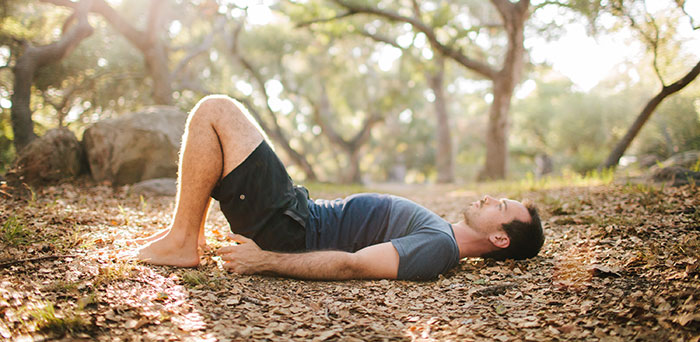
1. Laying on your back, bring your feet to stand right by your sitz bones.
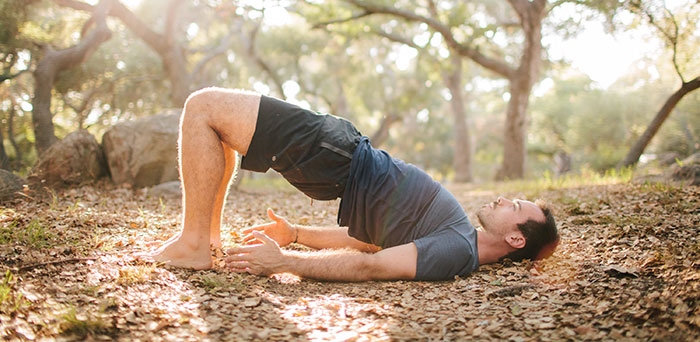
2. Exhale, press through your heels, and lift your hips.
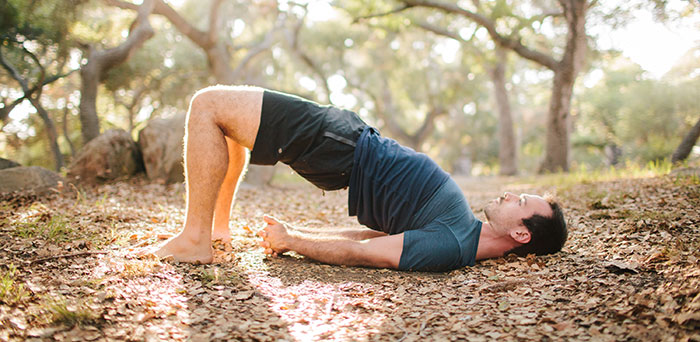
3-5. Wiggle your shoulder blades deep down your back, and clasp your fingertips. Lengthen your tailbone towards the backs of your knees. Stretch the fronts of your thighs. Magnetize your inner thighs together. Press the backs of your shoulders and forearms deep into the floor, to broaden your collarbones into this deep slow yoga pose.
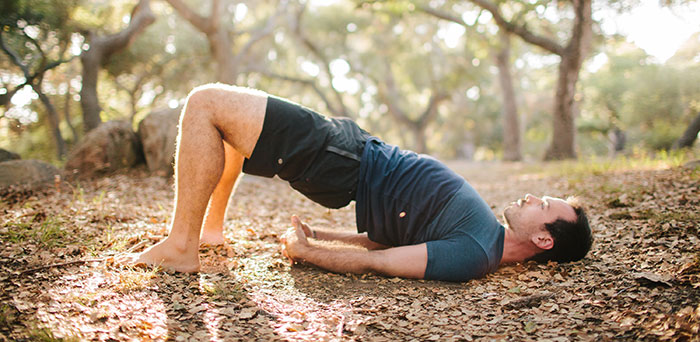
6-7. Lift your chin slightly away from the sternum, and gently lift your sternum back into your chin. Breath in the pose for 30 seconds to 1 minute. Exhale to release. Roll your spine slowly back to the earth as you come out of this powerful slow yoga pose.
Camatkarasana (Wild Thing) [Advanced]
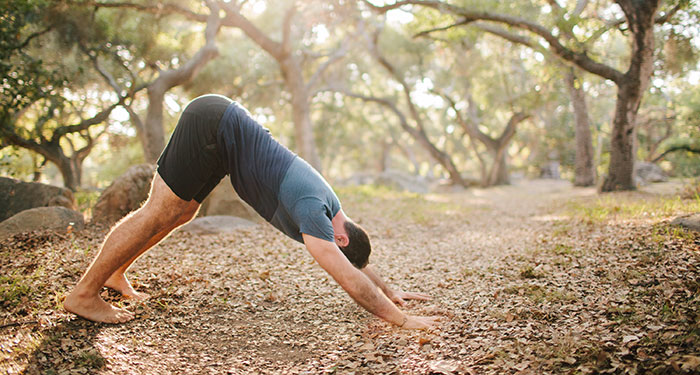
1-2. Start in Adho Mukha Svanasana (Downward-Facing Dog). Lift your right leg high to the sky.
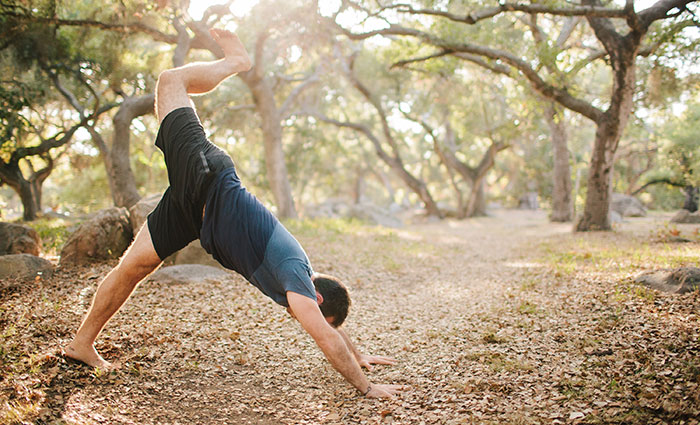
3-4. Bend your knee, and open up your hip. Press your weight into your left hand, and slowly spin onto the outside blade of your left foot.
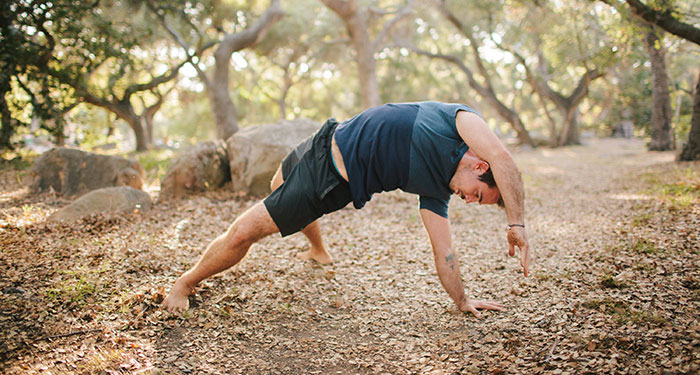
5-8. Keep floating your right leg up and over to the left. Externally rotate your upper left shoulder, gliding your left shoulder blade firmly down your back. Once your foot touches down, in one fluid motion, rotate your torso and hips towards the sky. On an inhalation, lift your hips with buoyancy, and lift your heart towards the sky. Lift your right arm, stretch your bicep up and over your ear. Let your neck lengthen and bring your gaze in between your eyebrows for the remainder of this part of the slow yoga pose.
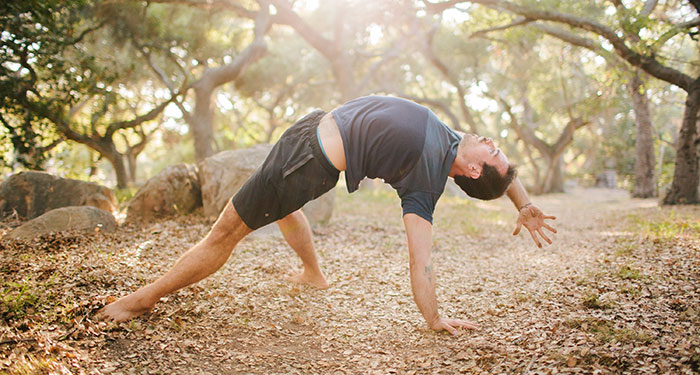
9-11. Keep breathing deeply. Root down through your left hand, clawing your fingertips into the ground, as you continue to lift your hips and torso for 5-10 breaths. Breath slowly in this yoga pose, letting the rush of adrenaline and exhilarating sense of strength and confidence soak deep into your chest, belly, and hips. To release: look back toward your left hand, bring your right hand back, and bring your right hip back up and over, returning back to Downward-Facing Dog, and repeat on the other side.
Upavistha Konasana (Seated Wide Angle Pose) [Beginner]
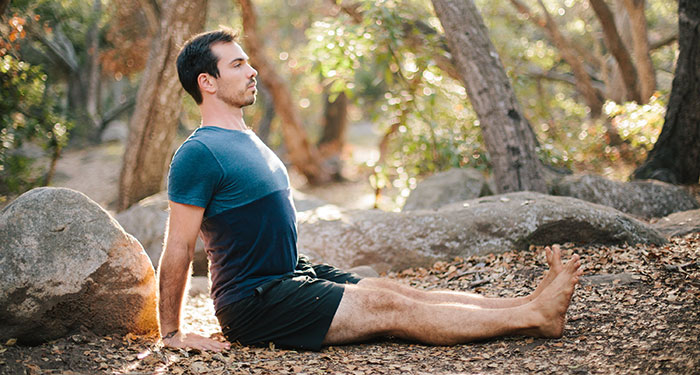
1-2. Sit in Dandasana (Staff Pose). Lean your torso back slightly on your hands and lift and open your legs to a wide angle.
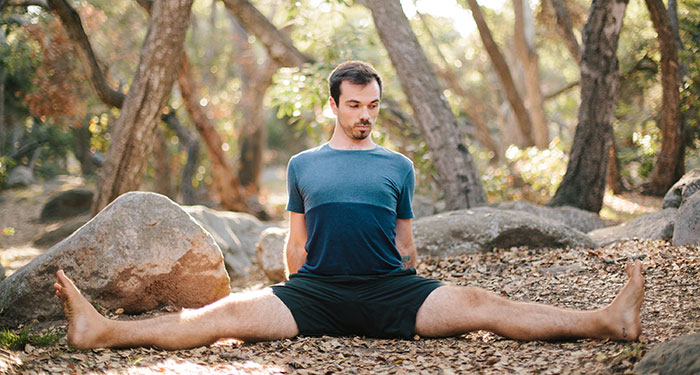
3. Press your hands against the floor and slide your buttocks forward, widening the legs another 10 to 20 degrees. (Raise your hips off the floor with a blanket if you can’t sit comfortably.)
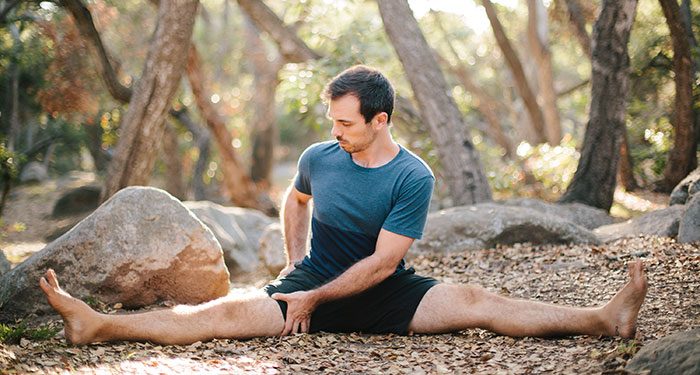
4-6.Take both hands to your right thigh, and rotate the inner thigh down, and outer thigh back; pulling the flesh of your buttocks back. Ensure the kneecaps point upward. Press the thigh bone down into the earth. Repeat with the other leg. Lift your kneecaps, and press out through the balls of your feet. Walk your hands out, between your legs, keeping your arms extended throughout the slow yoga pose.
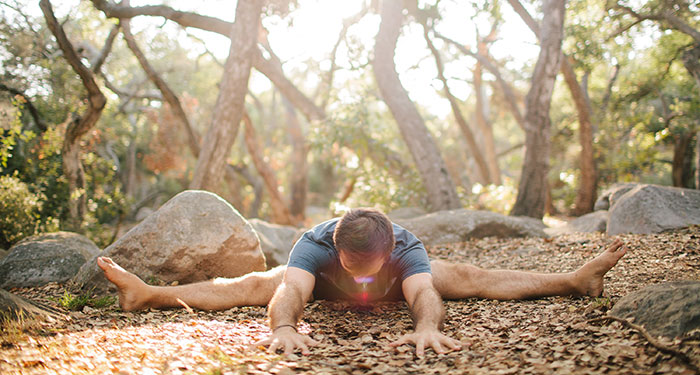
7-10. Hinge at the waist, using your hips to tilt your torso forward, stretching your spine long, as you bow forward. Breath here for 1-5 minutes, turning your attention inward to slowly stretch your lower back throughout the slow yoga movement. Modification: Bend your knees to take any strain off of your lower back and hamstrings. To release: On an inhale, rise up with the long torso, floating your rib cage to stack over your hips.
Kurmasana (Tortoise Pose) [Advanced]
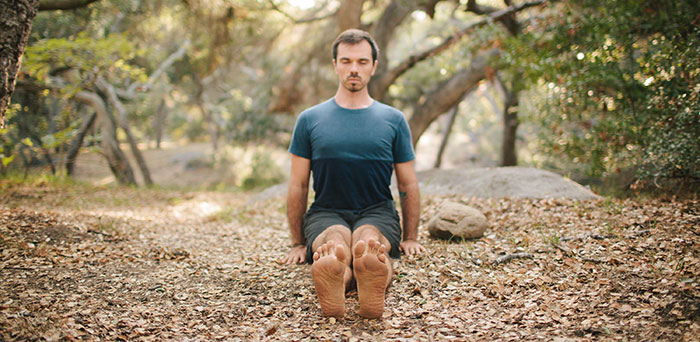
1. Sit in Dandasana (Staff Pose).
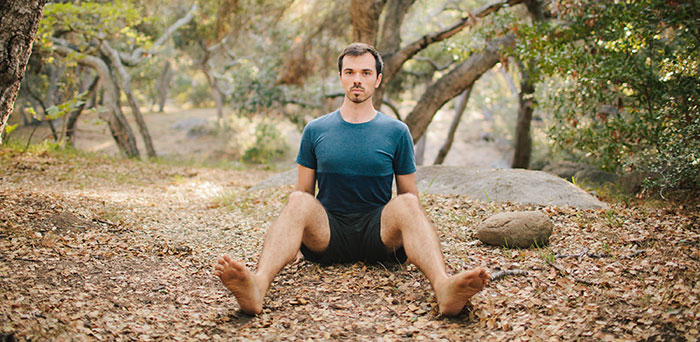
2-4. Walk your heels to the far corners of your mat. Bend your knees to 90 degrees. Draw your sit bones deep behind you, keeping your kneecaps pointed skyward.
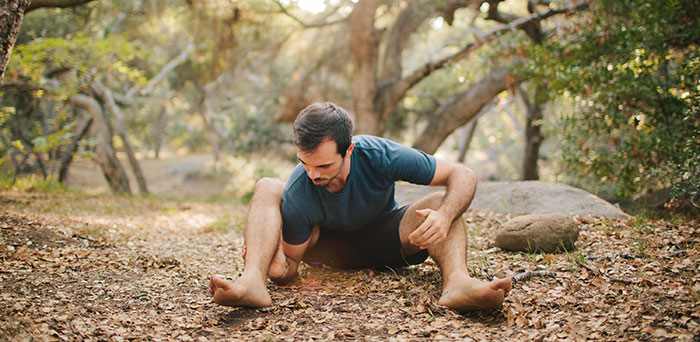
5-7. Bend at your hips and lean forward. With palms facing down, Slide one arm at a time, under your thighs and walk your palms away from your legs. Broaden your collarbones, and release your shoulders toward the floor.
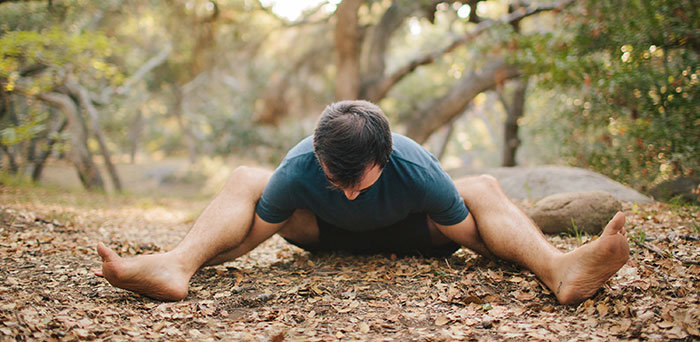
8-10. Work to straighten your legs, lift the kneecaps, and press out through the heels to stretch the legs long. Stretch your arms away from your shoulders. On an inhale, stretch your sternum and chin forward. On the next exhale, slide your heels farther apart, and reach your forehead forward, toward the floor. Breathe deeply in this deep slow yoga pose, and hold for 30 seconds to 1 minute and gently release by bending your knees, and lifting your torso.
About The Author
Matt Cooke is a neuroscience-based yoga teacher (500 RYT), author, and High Performance Coach who uses movement to unleash high performance for burnt out tech entrepreneurs. Matt studied extensively with Noah Maze and Elena Brower and his work is infused with Kripalu, Iyengar, and several coaching methodologies. Having conducted workshops and seminars all over the world, Matt is impassioned to inspire action and embodiment off the yoga mat. To learn more about Matt or get in touch with him, visit his website: mattcooke.yoga








